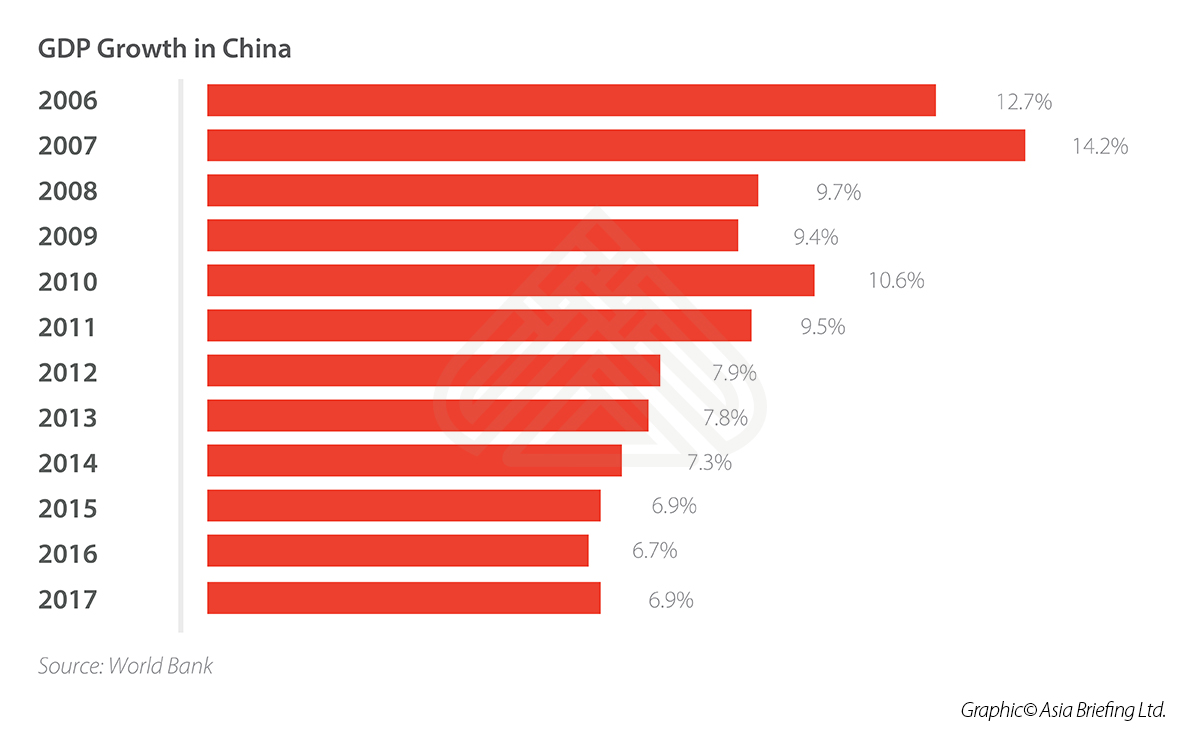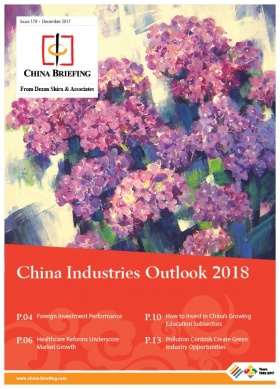The 2018 Two Sessions Meetings: Economic Growth, Reform Targets Set for China
The Chinese government announced its GDP growth target and policy priorities for 2018 at the annual Two Sessions meetings, China’s largest political event of the year.
This year’s Two Sessions meetings were overshadowed by October’s 19th Party Congress, where President Xi Jinping outlined a policy roadmap all the way to 2050, as well as the more recent announcement that the party plans to scrap presidential term limits.
These events precipitated debate over China’s long-term direction and the path the country will take going forward. However, the Two Sessions – while often broad and opaque – offer businesspeople a glimpse of how the government will carry out its plans in the immediate term, as well as how they fit into the larger economic picture.
![]() RELATED: The New Politburo Standing Committee in China
RELATED: The New Politburo Standing Committee in China
Economic growth target
In his annual Work Report, Premier Li Keqiang set China’s 2018 GDP growth target at “about 6.5 percent.” The goal is similar to last year’s target, though without the added “or higher if possible in practice” as stated last year, suggesting that Li is lightly tempering expectations for 2018.
In 2017, China’s GDP grew at a faster-than-expected 6.9 percent on the back of infrastructure stimulus, consumer spending, and a recovery in overseas demand for Chinese exports. This ended six consecutive years of slowing GDP growth, and brought the government closer to its promise of doubling 2010 GDP and per capita income levels by 2020.
Despite 2017’s robust growth, the government appears to be preparing for comparatively slower expansion in 2018, and perhaps beyond. In addition to refraining from mentioning faster growth ‘if possible’, Li announced that the budget deficit target would be lowered to 2.6 percent of GDP, down from three percent over the last two years, marking the first cut since 2012.
Although the budget deficit target is being lowered, China has put forward tax cuts and tax code simplifications to remain an attractive to investors. Li said that the government would cut up to RMB 800 billion (US$126 billion) worth of taxes for companies and individuals in 2018, representing the equivalent of 5.2 percent of 2018 receipts, or 5.5 percent of 2017’s revenue.
Some analysts attribute the tax cuts to pressure to compete with the massive cuts the US passed at the end of 2017, while other Asian countries have also lowered taxes in recent years. Meanwhile, China’s tax system remains complex – business should welcome measures to simplify the tax code.
Contextualizing the growth target
The 2018 growth targets come as Chinese leadership pursue a variety of campaigns designed to reform the country’s economy and society, which were reaffirmed in Li’s Work Report. Most notably, the government is looking to quell systemic risks in the economy – namely ballooning debt – and deepen its anti-pollution drive, while also pursuing an economic reform agenda.
Recent months have seen an intensification of the de-risking campaign, with corporate giants such as Anbang, CEFC, Dalian Wanda, HNA, and LeEco in the regulatory crosshairs. Meanwhile, local banks are also increasingly being fined and punished for doling out bad loans. With China’s banking and insurance watchdogs set to merge, and the government committed to cleaning up RMB 16 trillion (US$2.5 trillion) of local government debt, the deleveraging campaign looks set to ratchet up further in 2018.
Concurrently, the battle against air pollution has also accelerated, with the city of Beijing in particular registering huge improvements in air quality in recent months. In the Work Report, Li announced that anti-pollution spending would increase by 19 percent to reach RMB 40.5 billion (US$6.41 billion), with an aim to slash sulfur dioxide and nitrogen oxide emissions by three percent. While the anti-pollution campaign is undoubtedly positive for the environment, it could impact the economy in the short term due to the tighter regulation of polluting factories and industries.
Additionally, while some economic reforms – like administrative and regulatory streamlining – will encourage investment, other reform efforts may dampen growth in 2018. For instance, though Xi is not expected to liberalize state-owned enterprises (SOEs) – which would likely result in mass layoffs – the government is still seeking to reform SOEs to make them more efficient and less reliant on subsidies, which may result in a measure of short-term economic pain.
Similarly, the establishment of a new centralized anti-corruption body, the National Supervisory Commission, will expand the on-going anti-corruption campaign beyond the Communist Party to all public employees, including employees of SOEs and universities.
In the long run, reducing corruption could have a positive economic effect by reducing the misuse of public funds. But in the immediate term, it might lead to lower spending, and stall local-level investments and partnerships as officials take a wait-and-see approach to spending while they identify best practices.
Beyond these initiatives, China continues to face macroeconomic headwinds, such as its aging population and shift from cheap export-focused manufacturing to an economy defined by high-tech, innovation, and services. The Made in China 2025 industrial policy and possible liberalizations to family planning restrictions are designed to tackle these challenges over the long term, but will become even more pressing in 2018.
The prospect of a trade war with the US is a notable externality that could dampen GDP. China’s trade policies have often been a rhetorical target of US President Donald Trump, who recently expressed his wish to add tariffs on steel to the tariffs on washing machines and solar panels. If a trade war develops, it could have wide ranging and unpredictable effects on China’s economy.
Li promised that China would further open its markets to foreign investment – a measure that, if implemented, may defuse China-US tensions. However, he offered little in the way of specific measures, leaving the prospect of increased market access unclear at present.
![]() Business Intelligence from Dezan Shira & Associates
Business Intelligence from Dezan Shira & Associates
New focus on high quality growth
In his Work Report, Li reiterated the importance of “high quality growth”, a concept Xi emphasized at the 19th Party Congress. While minimizing the importance of GDP targets is politically convenient as growth slows, the emphasis on “high quality growth” is also reflective of China’s development.
As China becomes a wealthier country, with a more mature economy, GDP growth figures and relentless expansion have become less important, while socioeconomic issues such as employment, housing affordability, healthcare, and the environment have become greater concerns.
Indicators such as these are becoming more important for the government to monitor, and local officials have reportedly been instructed accordingly. Regions such as Inner Mongolia and Tianjin have been publically exposed in the media for smudging GDP statistics – a practice that the central government is looking to curb and disincentivize.
A wider array of indicators beyond GDP growth are being considered to assess local government performance, including environmental protection. Some regions in Hainan province have even abolished GDP targets completely in order to prioritize environmental protection.
The government has also set forward sweeping rural revitalization policies to address regional disparities, and potentially lift millions out of poverty. Policies such as these, if successful, may represent a more transformative effect on China’s economy than would be expressed in simple GDP terms.
China’s better-than-expected 2017 economic performance has given the government extra room to pursue its wide-ranging domestic policies. These policies are reflective of a new impetus to transform China, which could have positive economic effects in the long term, but may slow growth in 2018.
That being said, most economists expect China’s GDP to grow at 6.5 to 6.6 percent in 2018, in line with China’s projected targets. Although China’s economy is in a transitional phase, and growth may slow slightly compared to 2017, an expansion of “about 6.5 percent” would be the envy of many other countries around the world, and continue to offer opportunities for foreign investors.
About Us
China Briefing is published by Asia Briefing, a subsidiary of Dezan Shira & Associates. We produce material for foreign investors throughout Asia, including ASEAN, India, Indonesia, Russia, the Silk Road, and Vietnam. For editorial matters please contact us here, and for a complimentary subscription to our products, please click here.
Dezan Shira & Associates is a full service practice in China, providing business intelligence, due diligence, legal, tax, accounting, IT, HR, payroll, and advisory services throughout the China and Asian region. For assistance with China business issues or investments into China, please contact us at china@dezshira.com or visit us at www.dezshira.com
- Previous Article Hong Kong’s New Transfer Pricing Regime
- Next Article Beijing’s Service Sector: Market Opening Measures







